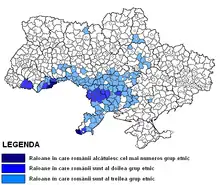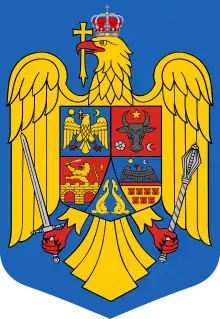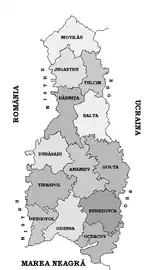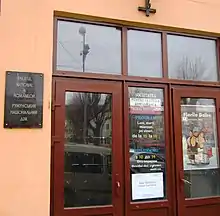Romanians in Ukraine
This article represents an overview on the history of Romanians in Ukraine, including those Romanians of Northern Bukovina, Zakarpattia, the Hertsa region, and Budjak in Odesa Oblast, but also those Romanophones in the territory between the Dniester River and the Southern Buh River, who traditionally have not inhabited any Romanian state (nor Transnistria), but have been an integral part of the history of modern Ukraine, and are considered natives to the area. There is an ongoing controversy whether self-identified Moldovans are part of the larger Romanian ethnic group or a separate ethnicity.
 Map of the raions of Ukraine where Romanians are the main ethnic group in dark blue, where they are the second biggest in lighter blue, and where they are the third in even lighter blue. | |
| Total population | |
|---|---|
| 150,989 (2001 census)[1] – 500,000 (Romanian estimates) | |
| Regions with significant populations | |
| Chernivtsi Oblast (12.5%) Zakarpattia Oblast (2.6%) | |
| Languages | |
| Predominantly Romanian (91.7%) | |
| Religion | |
| Predominantly Eastern Orthodox/Greek Catholic |
| Part of a series of articles on |
| Romanians |
|---|
 |
Because of the Soviet policies of artificial division of the Romanian speakers, and the continuation of those practices by the Ukrainian authorities, there is an undergoing identity controversy among the Romanophones of Ukraine. All of those living in the former territories of Bukovina consider themselves to be Romanians, but among those living in the lands of the historical Bessarabia, there is still division as a large part of them still consider themselves to be Moldovans, while many others identify as Romanians. This problem is considered to have worsened due to the poverty, the lack of proper education and the decades long disinformation of the inhabitants.
History
Middle Ages
Beginning with the 10th century, the territory was slowly infiltrated by Slavic tribes (Ulichs and Tivertsy) from the north, by Romanians (Vlachs) from the west, as well as by Turkic nomads such as Pechenegs, Cumans and (later) Tatars from the east.
Vlachs and Brodniks are mentioned in the area in the 12th and 13th century. As characterised by contemporary sources, the area between the Southern Bug and Dniester had never been populated by a single ethnicity, or totally controlled by Kievan Rus' or other rulers. Ukrainian historian Volodymyr Antonovych writes: "Neither the right bank, nor the left bank of the Dniester have ever belonged to Galician or other Ruthenian princes."
Since the 14th century, the area was intermittently ruled by Lithuanian dukes, Polish kings, Crimean khans, and Moldavian princes (such as Ion Vodă Armeanul). In 1681 George Ducas's title was "Despot of Moldavia and Ukraine", as he was simultaneously Prince of Moldavia and Hetman of Ukraine. Other Moldavian princes who held control of the territory in 17th and 18th centuries were Ștefan Movilă, Dimitrie Cantacuzino, and Mihai Racoviţă.
Modern Age
The end of the 18th century marked Imperial Russia's colonization of the region, as a result of which large migrations into the region were encouraged, including people of Ukrainian, Russian, and German ethnicity. The process of Russification and colonization of this territory started to be carried out by representatives of other ethnic groups of the Russian Empire.
While the Ruthenian ethnic element is fundamental for Cossacks, some have claimed a considerable number of Romanians among the hetmans of the Cossacks (i.e. Ioan Potcoavă, Grigore Lobodă (Hryhoriy Loboda), who ruled in 1593–1596), Ioan Sârcu (Ivan Sirko), who ruled in 1659–1660, Dănilă Apostol (Danylo Apostol), who ruled in 1727–1734, Alexander Potcoavă, Constantin Potcoavă, Petre Lungu, Petre Cazacu, Tihon Baibuza, Samoilă Chişcă, Opară, Trofim Voloşanin, Ion Şărpilă, Timotei Sgură, Dumitru Hunu), and other high-ranking Cossacks (Polkovnyks Toader Lobădă and Dumitraşcu Raicea in Pereiaslav, Martin Puşcariu in Poltava, Burlă in Gdańsk, Pavel Apostol in Myrhorod, Eremie Gânju and Dimitrie Băncescu in Uman, Varlam Buhăţel, Grigore Gămălie in Lubensk, Grigore Cristofor, Ion Ursu, Petru Apostol in Lubensk).
After 1812, the Russian Empire annexed Bessarabia from the Ottoman Empire. Romanians under Russian rule enjoyed privileges well, the language of Moldavians was established as an official language in the governmental institutions of Bessarabia, used along with Russian,[2] as 95% of the population was Romanian.[3][4]
The publishing works established by Archbishop Gavril Bănulescu-Bodoni were able to produce books and liturgical works in Moldovan between 1815 and 1820,[5] until the period from 1871 to 1905, when Russification policies were implemented that all public use of Romanian was phased out, and substituted with Russian. Romanian continued to be used as the colloquial language of home and family, mostly spoken by Romanians, either first or second language.
Many Romanians changed their family names to Russian. This was the era of the highest level of assimilation in the Russian Empire.[6] In 1872, the priest Pavel Lebedev ordered that all church documents be written in Russian, and, in 1882, the press at Chișinău was closed by order of the Holy Synod.
Historically, the Orthodox Church in today's Transnistria and Ukraine was subordinated at first to the Mitropolity of Proilava (modern Brăila, Romania). Later, it belonged to the Bishopric of Huşi. After the Russian annexation of 1792, the Bishopric of Ochakiv reverted to Ekaterinoslav (modern Dnipro). From 1837, it belonged to the Eparchys of Kherson with its seat in Odesa, and Taurida with its seat in Simferopol.
The Soviet Union
The population of the former Moldavian ASSR, as a part of the Ukrainian Soviet Socialist Republic (Ukrainian SSR), had also suffered the Holodomor, the famine of the 1930s that caused several millions deaths in Ukraine.
Autonomous Moldavian Republic in Soviet Ukraine

At the end of World War I in 1918, the Directory of Ukraine proclaimed the sovereignty of the Ukrainian People's Republic over the left bank of the Dneister. After the end of World War I in 1918, Bukovina (formerly ruled by Austria-Hungary) and Bessarabia were united with Kingdom of Romania; and after the Russian Civil War ended, in 1922, the Ukrainian SSR was created. Bukovina and Bessarabia were historically populated by the Romanians and Ukrainians for hundreds of years.
The very term "Ukrainians" was prohibited from the official usage and some populations of disputable Ukrainian ethnicity were rather called the "citizens of Romania who forgot their native language" and were forced to change their last names to Romanian-sounding ones.[7] Among those who were Romanianized were descendants of Romanians who were assimilated to Ukrainian society in the past.
As such, according to the Romanian census, of the total population of 805,000, 74% were Romanians; the number included the Ukrainians and other possibly related Ukrainian ethnic groups Hutsuls referred to as "Romanians who forgot their native language"[8] Among Russians who were Romanianized in Bessarabia were descendants of Romanians who underwent Russification policies during Russian rule.
The geopolitical concept of an autonomous Transnistrian region was born in 1924, when Bessarabian-Russian military leader Grigory Kotovsky founded, under the auspices of Moscow, the Moldavian Autonomous Oblast, which on 12 October 1924 became the Moldavian ASSR of the Ukrainian SSR.
The intention of Soviet policy was to promote Communism in recently lost Bessarabia and surroundings, and eventually to regain the former province from Romania. (Soviet authorities declared the "temporarily occupied city of Chişinău" as de jure capital of the ASSR.) The area was 8,100 km2 (3,100 sq mi) and included 11 raions by the left bank of Dniester.
Moldavian SSR

In 1940, under duress from a Soviet ultimatum issued to the Romanian ambassador in Moscow and under pressure from Italy and Germany, Romania ceded Bessarabia and Bukovina to the USSR. As many as 90,000 died as the Red Army entered and occupied the territory on June 28. The official Soviet press declared that the "peaceful policy of the USSR" had "liquidated the [Bessarabian] Soviet-Romanian conflict".
The Moldavian SSR was created from Bessarabia and the western part of the Moldavian ASSR. Bessarabian territory along the Black Sea and Danube, where Romanians were in the minority, was merged into the Ukrainian SSR to ensure its control by a stable Soviet republic.[9] The Romanian population of Ukraine was persecuted by Soviet authorities on ethnic grounds, especially in the years following the annexation until 1956; because of this, Russification laws were imposed again on Romanian population. In neighboring Bessarabia the same persecution did not have a predominantly ethnic orientation, being based mostly on social, educational, and political grounds.
Transnistria (WWII)
Having allied with Nazi Germany, and having recaptured the territories occupied by the Soviets in 1940, Romanian dictator Antonescu did not heed the counsel of his advisers and continued to wage war on the Soviets beyond Romania's pre-war boundaries, invading parts of Ukraine and occupying the territory between Dniester and Southern Buh rivers. During this period the Romanian and German authorities and units deported to this region 147,000 Bessarabian and Bukovinian Jews, 30,000 Romanian Roma, and exterminated the largest part of the local Jewish population of this region. In 1944, the Soviets re-conquered the area.
Recent past

In post-Soviet times, Ukrainian, the language of the historical ethnic/linguistic majority, is constitutionally the sole state language, and the state system of higher education has been switched to Ukrainian.[10]
In June 1997 Romania and Ukraine signed a bilateral treaty which included addressing territorial and minority issues.[11] By the terms of the agreement, Ukraine guaranteed the rights of Romanians in Ukraine and Romania guaranteed the rights of Ukrainians in Romania. There are schools teaching Romanian as a primary language, along with newspapers, TV, and radio broadcasting in Romanian.[12]
In 2015, several news websites published a report claiming that the Romanians of Northern Bukovina had formed a "Assembly of the Romanians of Bukovina" and demanded the territorial autonomy of the region from Ukraine. However, they were claimed to be fake and a product of pro-Russian anti-Ukrainian websites.[13][14]
Since 2014, the Romanians of Ukraine have been subject to forced Ukrainization by the Ukrainian authorities, despite constant objection of the Romanian authorities,[15][16][17][18] with some Romanian organizations in Ukraine even calling it a cultural genocide.[19][20] In 2022 and 2023, the Ukrainian Parliament adopted and amended laws that enshrined the rights of "national minorities" and allowed "holding public and cultural events and publishing advertisements fully in the language of national minorities within the given community."[21]
Modern mass media of the Romanians in Ukraine include the newspapers Zorile Bucovinei, Concordia, Libertatea Cuvântului, Gazeta de Herța and several more, as well as some TV and radio channels.[22]
Language and demographics
According to the Soviet 1989 census, Romanian speakers accounted for just under one percent of Ukraine's total population: 134,825 Romanians, and 324,525 Moldovans with the largest minority in Chernivtsi (approximately one fifth of the region's population). According to the U.S. Census Bureau, in 2015, there were 1,438 ethnic Romanians born in Ukraine living in the United States of America.[23] By comparison, there were also 237,809 ethnic Ukrainians born in Ukraine living in the U.S. in that year.[24]
Romanian speakers are not, as of 28 September 2017, allowed to learn exclusively in the Romanian language in the Ukrainian state education system after four years of education, with Romanian language instruction being restricted to separate Romanian language and literature classes.[25] Whereas, the Ukrainian migrants, as well as the ethnic Ukrainians who have lived in Romania for centuries, benefit from Ukrainian language classes in Romania and their state tv is broadcast on Romanian state's television at a chosen prefixed time slot.
| Year | Pop. | ±% |
|---|---|---|
| 1926 | 1,530 | — |
| 1939 | 825 | −46.1% |
| 1959 | 100,863 | +12125.8% |
| 1970 | 112,141 | +11.2% |
| 1979 | 121,795 | +8.6% |
| 1989 | 134,825 | +10.7% |
| 2001 | 151,989 | +12.7% |
| Soviet and Ukrainian censuses | ||
Romanian communities in present-day Ukraine
| Region | Population |
|---|---|
| Chernivtsi Oblast | 114,555 (12.5%) in 2001, with 67,225 self-identifying as Moldovans (7.3%), out of which 61,598 declared their native language as Moldovan, and 2,657 who declared it to be Romanian[27] Among the Moldovans whose native language was not Moldovan, 1,672 declared that they knew Romanian, and 1,391 that they knew Moldovan.[28] |
| Zakarpattia Oblast | 32,152 mainly living in Tiachiv Raion with 21,300 (12.4% of the rayon population) and Rahiv with 10,300 (11.6% of the rayon population). Some 10,000–15,000 also live in the northern part of the oblast, far from other Romanian communities, and are referred to as volohi in Romanian. They are also controversially referred to as țigani albi ("White Gypsies") by some researchers.[29][30] |
| Odesa Oblast | 724, with 123,751 self-identifying as Moldovans[31] |
| Total | 150,989, with 258,619 self-identifying as Moldovans, out of which 181,124 declared Moldovan as their native language, and 2,790 declared Romanian as their native language[32] |
| Raion | Population |
|---|---|
| Hertsa Raion | 32,316, including 29,554 Romanians (91.5%) and 1616 who declared themselves Ukrainians (5%), and 756 Moldovans (2.3%), out of which 511 declared their language Moldovan and of which 237 called their language Romanian[34] |
| Hlyboka Raion | 72,676, of which: Ukrainians: 34,025, Romanians: 32,923, Moldovans, including 3,882 who declared their native language to be Moldovan and 56 who stated that it was Romanian: 4,425, Russians: 877, and other: 426[35] |
| Novoselytsia Raion | 87,461, of which: 50,329 Moldovans (out of which 47,585 self-identified their language as Moldovan and 2,264 as Romanian), 29,703 Ukrainians, 5,904 Romanians, 1,235 Russians, 290 other[36] |
| Settlement | Population |
|---|---|
| Boiany | It has 4,425 inhabitants, mostly Romanian (Moldovan). |
| Chernivtsi | In 2001, population was 236,691, of which 189,021 (79.9%) are Ukrainians; 26,733 (11.3%) Russians; 10,553 (4.5%) Romanians; 3,829 (1.6%) Moldovans; 1,408 (0.6%) Polish; 1,308 (0.6%) Jews; 2,868 (1.2%) other nationalities.[37] |
| Hertsa | The town has a large Romanian majority. |
| Hlyboka | According to the 1989 census, the number of Romanians/Moldovans was 20.11%. |
| Krasnoilsk | according to the 2001 Ukrainian census, the town had 9,142 people, out of which almost all are Romanians. |
| Novoselytsia | The city has a population of 8,166 people, mainly Ukrainians, with an important Romanian community. |
Notable individuals
Notable Romanians (or individuals with partial Romanian ancestry) in Ukraine include:
- Aurica Bojescu - lawyer, minority rights activist and politician
- Nikolay Florea - astronomer
- Alexander Marinesko - naval officer
- Igor Moiseyev - choreographer
- Volodymyr Muntyan - footballer
- Mihail Pop - economist and politician in Moldova
- Serghei Covalciuc - footballer
- Kyrylo Kovalchuk - footballer
- Alina Grosu - singer
- Sofia Rotaru - singer
- Nataliia Lupu - athlete
- Tatiana Gutsu - artistic gymnast
- Nichita Smochină - scholar and political figure
- Eugen Tomac - historian and politician
- Maria Iliuț - folk singer
- Petro Mohyla - Orthodox metropolitan
- Alexandru Averescu - Marshal of Romania and Prime Minister of Romania
- Pavlo Unguryan - conservative politician and Evangelical leader
- Arseniy Yatsenyuk - Prime Minister of Ukraine
- Vasile Tărâțeanu - writer and activist
- Miroslava Șandru - ethnographer and folklorist
- Vitaliy Pushkutsa - footballer
- Maksym Braharu - footballer
- Ivan Balan - footballer
- Ivan Bodiul - First Secretary of the Moldavian Communist Party
- Petro Bolbochan - colonel of the Ukrainian People's Army
- Lilia Sandulesu - pop singer
- Yevhen Levytskyi - diplomat
- Teofil Rendyuk - diplomat
- Ion Popescu - politician
- Longinus (Jar) - Metropolitan of the Ukrainian Orthodox Church
- Siluan (Ciornei) - bishop of the Ukrainian Orthodox Church
- Vladimir (Moroz) - Metropolitan of the Ukrainian Orthodox Church
See also
- Demographics of Ukraine
- Moldovans in Ukraine
- Hertsa region
- Northern Maramureș
- Bessarabia
- Bukovina (Bukovina Day)
- New Serbia, a province in the Russian Empire that had an ethnic Romanian majority
- Slavo-Serbia, another province of the Russian Empire that had a notable minority of Romanian colonists
- Romania–Ukraine relations
References
- Ion Popescu and Constantin Ungureanu, Romanii dn Ucraina - intre trecut si viitor, vol. 1 (Romanii din Regiunea Cernauti), Cernauti, 2005, p. 24, with the figure from the 2001 Ukrainian census. An additional 258,619 people identified themselves as Moldovans.
- (in Russian)Charter for the organization of the Bessarabian Oblast, April 29, 1818, in "Печатается по изданию: Полное собрание законов Российской империи. Собрание первое.", Vol 35. 1818, Sankt Petersburg, 1830, pg. 222–227. Available online at hrono.info
- Ciobanu, Ștefan (1923). Cultura românească în Basarabia sub stăpânirea rusă. Chișinău: Editura Asociației Uniunea Culturală Bisericească. p. 20.
- The Memory of (Im)Proper Names from Basarabia
- King, Charles, The Moldovans, Hoover Press, 2000, ISBN 0-8179-9792-X, pg. 21–22
- Colesnic-Codreanca, Lidia. Limba Română în Basarabia. Studiu sociolingvistic pe baza materialelor de arhivă (1812–1918) ("The Romanian language in Bessarabia. A sociolinguistic study based on archival materials (1812–1918)"). Chișinău: Editorial Museum, 2003.
- Oleksandr Derhachov (editor), "Ukrainian Statehood in the Twentieth Century: Historical and Political Analysis", Chapter: "Ukraine in Romanian concepts of the foreign policy", 1996, Kiev ISBN 966-543-040-8
- Harvard Ukrainian Studies, Harvard Ukrainian Research Institute, 1988, p.191
- Charles King, The Moldovans: Romania, Russia, and the politics of culture, Hoover Institution Press, Stanford University, 2000. ISBN 0-8179-9792-X.
- INCONSISTENT LANGUAGE POLICY CREATES PROBLEMS IN UKRAINE, Oleg Varfolomeyev, EURASIA DAILY MONITOR, Volume 3, Issue 101 (May 24, 2006), available online at "The Jamestown Foundation". Archived from the original on 2006-08-22. Retrieved 2006-08-29.
- U.S. Department of State
- Dominique Arel, "Interpreting 'Nationality' and 'Language' in the 2001 Ukrainian Census," Post-Soviet Affairs, Vol. 18 No. 3, July–September 2002, pp. 213–249, available online in JRL #6535 at
- "Fals: Românii din Bucovina cer de la Poroșenko autonomie teritorială" (in Romanian). StopFake. 22 June 2016.
- Melniciuc, Liubov (23 September 2020). "Inexistenta "Adunare a românilor din Bucovina" și varianta bucovineană a unui separatism inventat". EuroPunkt (in Romanian).
- "De ce Ucraina promovează "limba moldovenească" braț la braț cu Rusia agresoare?".
- "Cum s-a ajuns la deznaționalizarea românilor din Ucraina". 10 May 2022.
- Liberă, Europa (16 July 2020). "Românii din Ucraina reclamă lipsa de interes a autorităților de la București". Europa Liberă România.
- https://www.agerpres.ro/social/2016/06/12/reportaj-comunitatea-romaneasca-din-regiunea-cernauti-amenintata-de-pericolul-asimilarii-si-deznationalizarii-prin-ucrainizarea-scolilor-12-39-22
- "Românii din Ucraina denunţă "un genocid cultural-lingvistic" împotriva lor". 16 July 2020.
- "Romanii din Ucraina acuza un "genocid cultural-lingvistic" in timp ce statul roman reactioneaza "mai mult decat modest"".
- "Parliament approves changes to national minorities law". The Kyiv Independent. 2023-09-21. Retrieved 2023-10-20.
- "Mass Media româno-ucrainene" (in Romanian). Consulate of Romania, Solotvyno. Retrieved 21 October 2023.
- "Explore Census Data".
- "Explore Census Data".
- "Beyond the scandal: what is Ukraine's new education law really about?". openDemocracy. Retrieved 2023-10-20.
- Center for the Prevention of Conflicts and Early Warning, Nr. 704R/June 19, 2004
- Ion Popescu and Constantin Ungureanu, Romanii dn Ucraina - intre trecut si viitor, vol. 1 (Romanii din Regiunea Cernauti), Cernauti, 2005, p. 242, 266, with the figures from the 2001 Ukrainian census.
- Ion Popescu and Constantin Ungureanu, Romanii dn Ucraina - intre trecut si viitor, vol. 1 (Romanii din Regiunea Cernauti), Cernauti, 2005, p. 266, with the figures from the 2001 Ukrainian census.
- "Volohii din Carpații Păduroși (Ucraina) - o ruină de românitate". Gazeta de Maramureș (in Romanian). 9 August 2021.
- Ion Popescu and Constantin Ungureanu, Romanii dn Ucraina - intre trecut si viitor, vol. 1 (Romanii din Regiunea Cernauti), Cernauti, 2005, p. 42, with the figures from the 2001 Ukrainian census.
- Ion Popescu and Constantin Ungureanu, Romanii dn Ucraina - intre trecut si viitor, vol. 1 (Romanii din Regiunea Cernauti), Cernauti, 2005, p. 33, 45, with the figures from the 2001 Ukrainian census.
- Ion Popescu and Constantin Ungureanu, Romanii dn Ucraina - intre trecut si viitor, vol. 1 (Romanii din Regiunea Cernauti), Cernauti, 2005, p. 24, 266, with the figures from the 2001 Ukrainian census.
- File:EthnicChernivtsi 2001UkrCensus.png
- Ion Popescu and Constantin Ungureanu, Romanii dn Ucraina - intre trecut si viitor, vol. 1 (Romanii din Regiunea Cernauti), Cernauti, 2005, p. 260-261, with the figures from the 2001 Ukrainian census.
- Ion Popescu and Constantin Ungureanu, Romanii dn Ucraina - intre trecut si viitor, vol. 1 (Romanii din Regiunea Cernauti), Cernauti, 2005, p. 257, 258, with the figures from the 2001 Ukrainian census.
- Ion Popescu and Constantin Ungureanu, Romanii dn Ucraina - intre trecut si viitor, vol. 1 (Romanii din Regiunea Cernauti), Cernauti, 2005, p. 259, 260, with the figures from the 2001 Ukrainian census.
- Ion Popescu and Constantin Ungureanu, Romanii dn Ucraina - intre trecut si viitor, vol. 1 (Romanii din Regiunea Cernauti), Cernauti, 2005, p. 246, with the figures from the 2001 Ukrainian census.
- Ion Nistor. The History of Romanians in Transnistria
- Charles King. The Moldovans: Romania, Russia, and the Politics of Culture, Hoover Institution Press, Stanford University, 2000. ISBN 0-8179-9792-X.
External links
- INCONSISTENT LANGUAGE POLICY CREATES PROBLEMS IN UKRAINE, Oleg Varfolomeyev, EURASIA DAILY MONITOR, Volume 3, Issue 101 (May 24, 2006)
- "Interpreting 'Nationality' and 'Language' in the 2001 Ukrainian Census,", Dominique Arel, Post-Soviet Affairs, Vol. 18 No. 3, July–September 2002, pp. 213–249, appearing in JRL #6535
- The Romanian Minority in Ukraine, Ionas Aurelian Rus, Center for Prevention of Conflicts and Early Warning, Policy Paper Nr. 704R, Bucharest, June 2004
